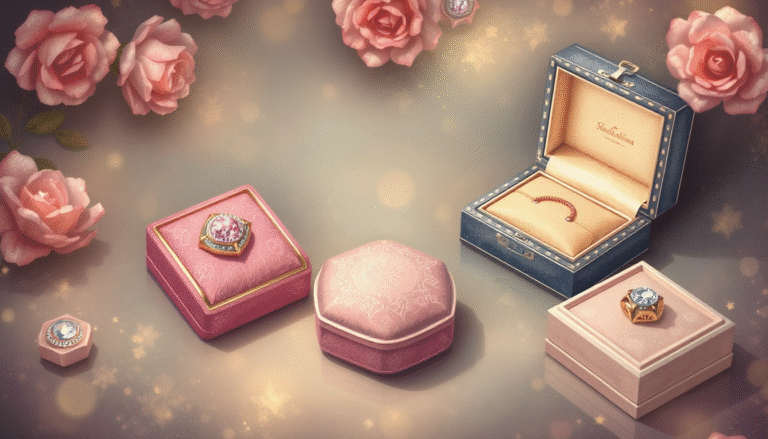More Than a Box: Unveiling the Cultural Treasure Within
For a moment, it appears to contain treasures. Peer more closely and it is the treasure. The wood jewelry box from China is so much more than just a place to store your rings and necklaces. It is a little dollop of cultural DNA, a vessel that contains history and artistry in equal measure. To like a single one is to have a millennium in your hand.
Your welcome to search beyond the function and discover the form, story, and soul of this amazing piece. In this guide, we will take a closer look at the rare woods and the complex techniques handed down among generations. We will learn to read the deep symbolic language that has been carved into its surfaces and we will gain the practical wisdom of how to select this instrument which speaks to you, whether it is antique or modern.
Leverage The Distinct Features of a Chinese Wooden Jewelry Box Buying a chinese wooden jewelry box is not just only for stashing things in it. It’s also about plugging into a tradition of creativity and significance, turning a mundane device into a meaningful sign of cultural appreciation.
A Legacy in Wood: Key Materials and Traditional Techniques
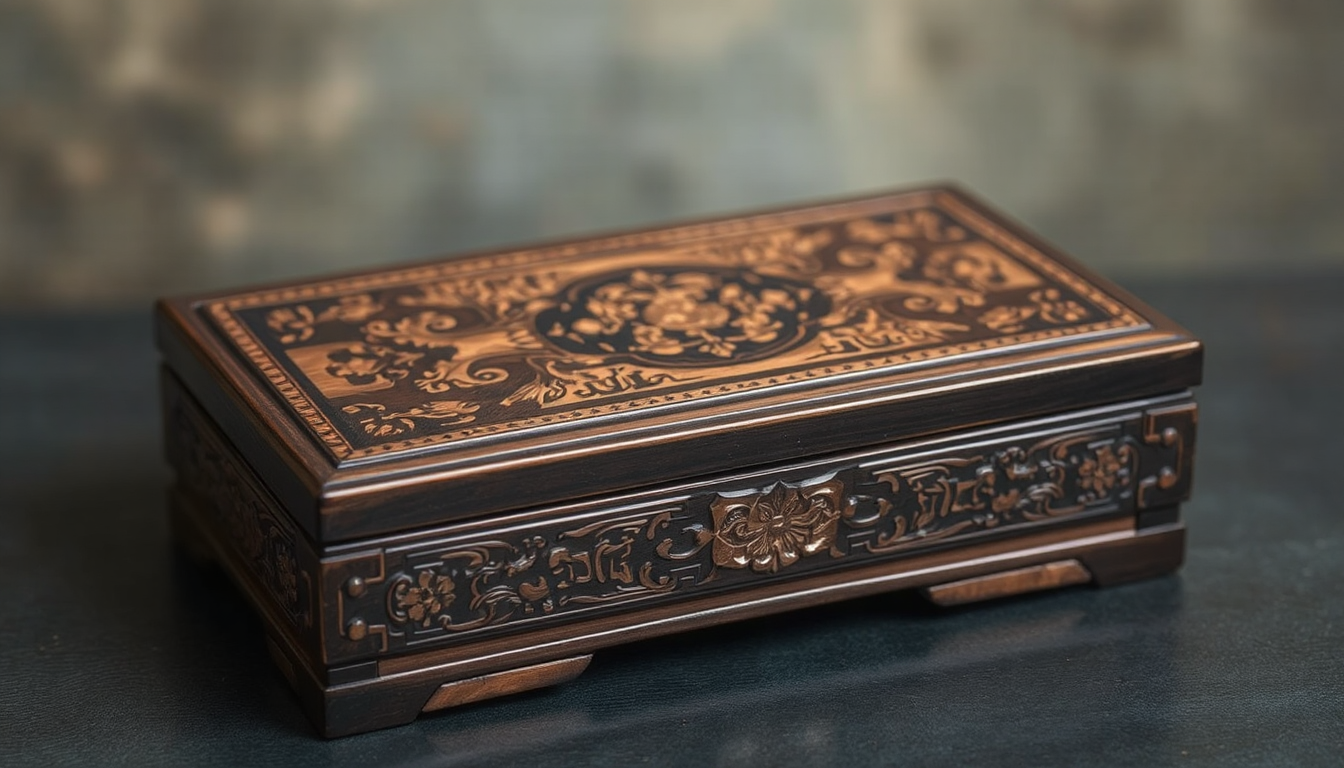
The character of a Chinese wooden jewelry box begins with its most fundamental element: the wood. The choice of material is never random; it is a statement of value, purpose, and beauty. The craftsmanship that shapes this wood, often involving techniques perfected over dynasties, is what brings life to the piece. Understanding these materials and methods is the first step toward true appreciation. These traditions are part of a vast legacy of traditional Chinese woodworking techniques that have long been respected.
The Soul of the Wood: From Rosewood to Camphor
Craftsmen choose woods not just for color and grain, but density and even smell. Some woods were once reserved just for the imperial court or the literati, while others were picked for practical benefits, such as keeping away insects.
Following are some of the most highly regarded woods used in classic Chinese furniture and decorative boxes:
| Wood Type | Key Characteristics | Common Use/Significance |
| Zitan (紫檀, Rosewood) | Extremely dense, deep purplish-red to black, subtle fragrance. | Imperial furniture and high-value objects; prized for its regal color and rarity. |
| Huanghuali (黄花梨) | Golden-brown to reddish-brown, prized for its ghostly, abstract grain patterns (“ghost faces”). | The choice of scholars and connoisseurs; valued for its stunning visual beauty. |
| Jichi Mu (鸡翅木, “Chicken-wing” wood) | Streaked with dark brown and black in a pattern resembling feathers. | Used for its striking visual appeal and dramatic, alternating grain. |
| Zhang Mu (樟木, Camphor) | Lighter in color, famous for its strong, pleasant aroma and natural insect-repelling oils. | Ideal for storage chests and box linings, protecting delicate textiles and items. |
The Artisan’s Touch: Signature Craftsmanship
There’s, of course, the fact that in terms of decorative techniques, the simple box becomes a work of art. These are methods which need time, patience and a steady hand.
Lacquering: This is not basic painting. Genuine lacquerware calls for dozens of thin coats of the lacquer tree’s sap. It must be laid on with care, and in a warm, damp situation left to dry and to be polished. This makes for a super strong, deep finish, from which you can add color (cinnabar for a bright red or carbon for a deep black) using pigments.
Inlay (镶嵌): This is the process of setting one material into another to form a smooth decorative surface. Artisans carve shallow pits into the wood and neatly fit into them small pieces of glossy mother-of-pearl and precious jade, bone, or other wood to form intricate scenes of people, lands, and patterns.
Carving (雕刻): The most dramatic technique, carving transforms a flat surface into a three-dimensional story. Whether carving in low relief for delicate depth or in high relief to make figures appear as if they were leaping out of the material, the carver’s talent animates the design.
Decoding the Imagery: A Guide to Chinese Symbolism
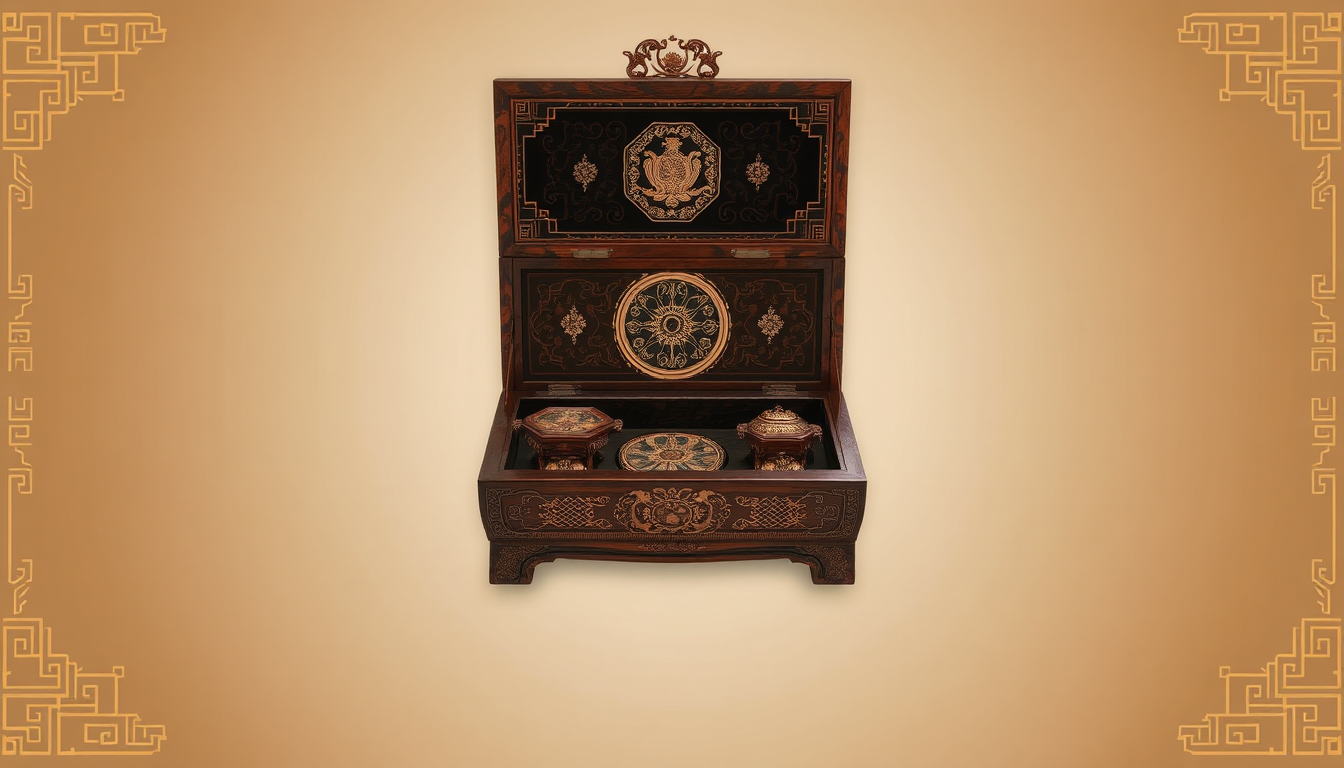
To a casual viewer, the carvings on a chinese wooden jewelry box are beautiful decorations. To those who understand their meaning, they are a rich tapestry of stories, blessings, and wishes. Each part is part of a visual language showing desires for long life, wealth, happiness, and harmony. This deep well of meaning is a key feature of all symbolism in Chinese decorative arts.
Mythical Guardians and Auspicious Beasts
Mythology offers some of the most potent symbols, displaying cosmic forces and imperial authority.
-
The Dragon (龙): The most powerful of all the zodiac animals represents dignity, success, and luck. The dragon is associated with the emperor and his control over the elements — particularly water and rain. Stamped on a box, it’s an easy, effective marker of success and power.
-
The Phoenix (凤):regarded as the queen of birds, the phoenix symbolizes beauty, good fortune, and the empress. It only comes in times of peace and prosperity. When the dragon and phoenix are together they represent one of the strongest images of all: harmony and marriage.
The Language of Flora and Fauna
Nature offers a wide-ranging vocabulary to express wishes and ideas — frequently with jokey puns based on the way words sound.
-
Peony (牡丹): The peony is recognized as the “king of flowers.” The flower is a symbol of wealth, high status and honor. Such a full, rich bloom is symbolic of wealth and luxury.
-
Lotus (莲花): The lotus rising out of muddy water and blooming in pure beauty is an emblem of purity, integrity, and spiritual insight in Buddhism. Lotus (lián) also sounds like continuous or successive, and so it may stand for the wish for many sons.
-
Bats (蝠): This might look like an odd symbol for luck, but it is another example of a Chinese pun. The word fú (for bat) sounds the same as fú (for “good fortune”). Five bats are an even more auspicious sight, symbolizing the Five Blessings: long life, riches, health, love of virtue and a natural death.
-
Cranes (鹤): Revered as majestic, long living birds that are auspicious, cranes are a primary symbol of longevity and immortality. They are frequently depicted with pine trees or peaches, other symbols of long life, making for a potent blessing for the box’s owner.
A Practical Guide to Choosing Your Chinese Wooden Jewelry Box
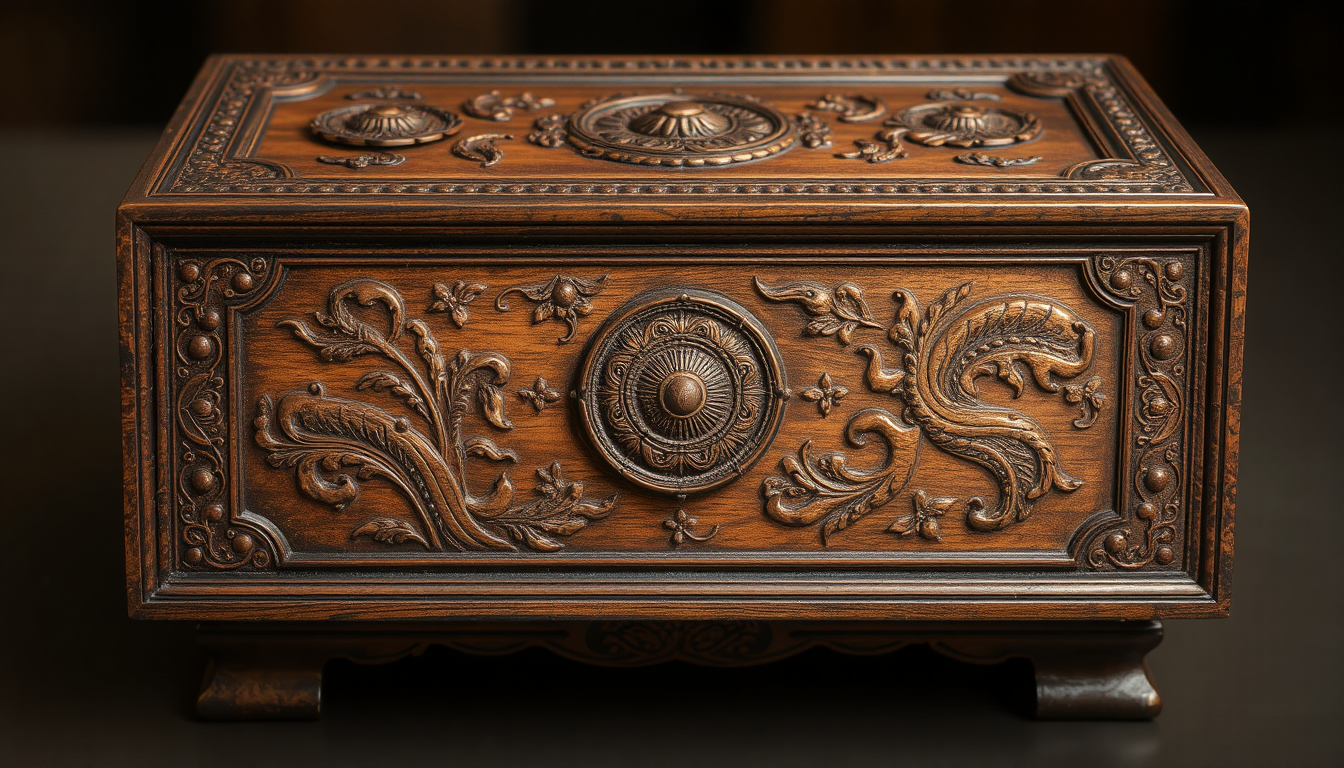
Whether you’re seeking something contemporary and approachable or something more historic and filled with stories, here’s what it all comes down to. But armed with that practical, on-the-ground experience, this guide will give you the means to assess quality and authenticity, so you can pick a box that you’ll treasure.
Selecting a New, Modern Box
New manufacturing has produced the modern boxes, which combine traditional looks and new methods. Quality can differ dramatically, so a close inspection is important.
Checklist for Quality:
-
Wood & Finish: Run your hand along the surface. A standard finish is smooth and consistent, not drippy or bubbly. The wood grain, while perhaps common, should be handsome and of good figure.
-
Joinery: This is one of the biggest indictors of quality. Look for precise corners. Is it neatly dovetailed or is the stuff just glued and nailed? When inspecting joinery, run a finger over the corners. You should feel the seam only as a smooth transition — not a rough, glued edge.
-
Hardware: Check out the brass or metal fittings. They should be solid, not rickety. The lock, hinges and hasp must be attached firmly and operational without snagging or loosening.
-
Interior: The lining, often silk, brocade, or velvet, should be applied neatly. Look for clean corners without excess glue spots or frayed edges. Drawers should slide smoothly and fit well, not rattle loosely. A well-made box has a certain weight and solid feel that cheaper, veneered versions lack.
Identifying an Authentic Vintage or Antique Box
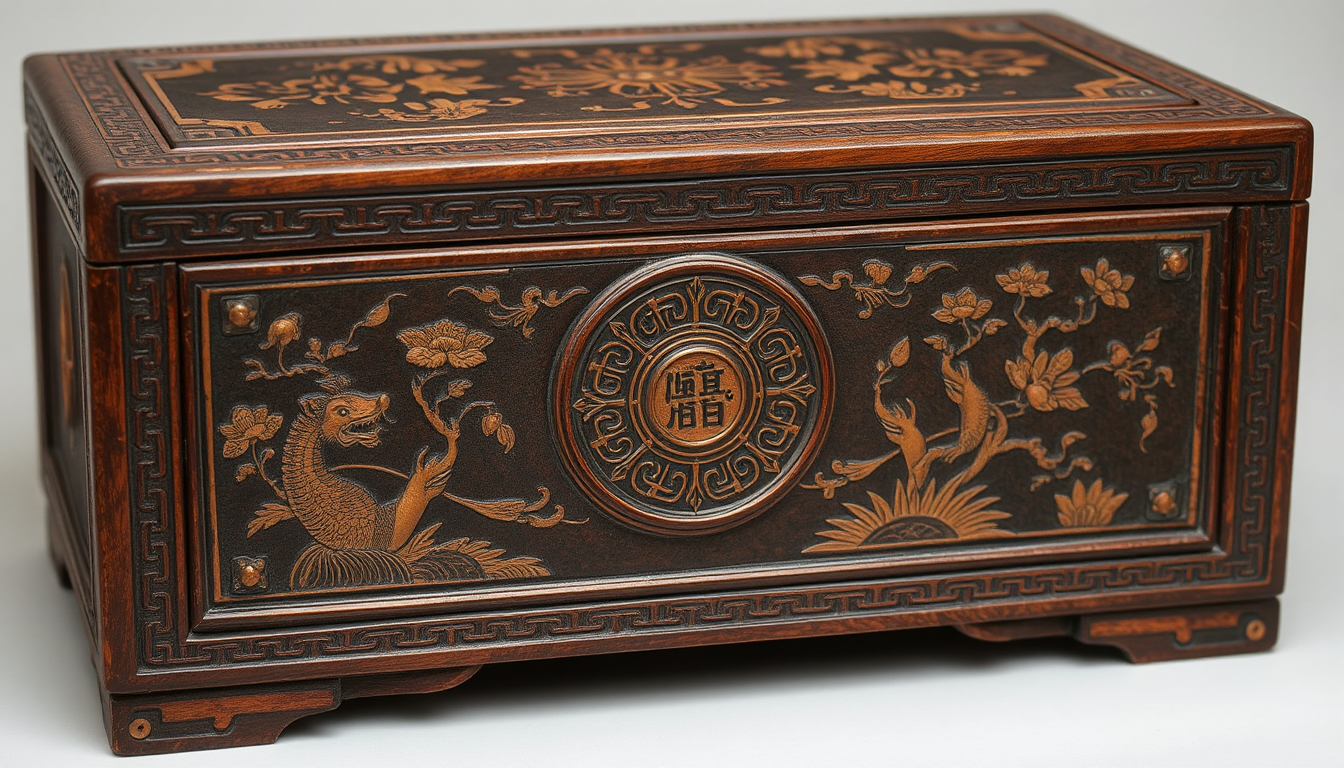
It takes a detective’s eye to spot a genuine antique. You want the authentic signs age, not the faux version. Many so-called “antique-style” boxes were made during the mid-to-latter part of the 20th century for export, while actual items from the Qing Dynasty (1644-1912) are much less common and display evident signs of hand work.
Signs of Age to Look For:
-
Patina: This should be your top indicator. It’s a warm, soft, dust-and-handling-inflected shine that accumulates on wood over the decades, taking on a lived-in character as it picks up dust, is wiped, dusted and handled again. You can’t fake it with a glossy, fresh varnish. More bold in areas that have been handled and muted in crevices.
-
Honest Wear and Tear: “You’ll want to find wear in the logical places,” says Goldenberg, “like some smoothing on the corners, a few small scuffs on the bottom, and any darkening around the metal hasp or lock from years of being touched.” Super-regular “distressing” is also a red flag.
-
Hardware: Now-degenerate, hand-cast brass hardware will be a touch flawed, darker and less fancy than the shiny, hard-edged, molded things sent in batches out of some plastic factory. Check for signs of oxidation or green patches in the nooks.
-
Construction: Examine the interior and bottom. Do you see signs of hand-planing or slight irregularities that show hand tools were used? True antiques are rarely perfectly even.
Quick Comparison: Modern Reproduction vs. Genuine Antique
| Feature | Modern Reproduction | Genuine Antique |
| Weight | Often lighter; may use veneers over composite board. | Heavier and more substantial; typically solid wood. |
| Finish | Uniform, high-gloss, often polyurethane. Looks and feels like plastic. | Soft, uneven patina from age and use. Feels like waxed wood. |
| Joinery | May use modern glues, staples, or nails. Can have perfect machine-cut joints. | Traditional joinery (e.g., dovetails, mortise and tenon), often with slight gaps from wood movement. |
| Hardware | Shiny, uniform, machine-made. Perfectly symmetrical screws. | Hand-forged, may show oxidation, pitting, or slight asymmetry. |
| Symmetry | Generally perfectly symmetrical and uniform. | Minor imperfections and asymmetries, tell-tale signs of hand-tooling. |
Preserving Your Treasure: Care and Maintenance Tips
A quality chinese wooden jewelry box is built to last for generations, but it needs simple, proper care to protect it from damage. The goal is to keep its condition, not to make it look brand new.
Do’s and Don’ts of Care
-
DO:Wipe free of dust once a week with a soft, dry microfiber cloth. For carved details, the best way we’ve found to dust is with a soft, natural-bristle artist’s brush, as cloths can snag on the fine edges.
-
DO:Store the box in a climate-controlled environment. Don’t set it in direct sunlight where the finish may fade, or near radiators and heating vents, which can dry out and crack the wood.
-
DO: Be gentle with the box, raising it from the bottom instead of the lid or a handle.
-
DON’T: Use commercial furniture polish, waxes or any type of harsh chemical cleaners. These cleaners can harm the original lacquer or patina, and can leave behind a sticky residue that collects more dirt.
-
DON’T: Store the box in a damp basement or attic. The thematically worst: Growing and shrinking of the wood due to big swings in humidity. For the interior, a low-power hand-held vacuum can lightly suck away dust from the fabric lining.
A Timeless Connection to Art and History
The quest to understand a chinese wooden jewelry box carries us much further than simply its material structure. We go from admiring the beauty of its wood and the artistry of its making to reading the histories and blessings encoded in its symbolic carvings. We come to know the tokens of time in an authentic antique from the common air of a modern one. Ultimately, we come to understand that to select, acquire, and protect one of these objects is to become a guardian of a small part of our cultural history. It’s an eternal link to an enduring beautiful legacy.
FAQ
-
What are the most valuable woods used in traditional Chinese wooden jewelry boxes?
The most valued woods for rosewood furniture are zitan (purple rosewood), huanghuali (golden-brown wood with “ghost face” grain patterns), jichi mu (“chicken-wing” wood), and zhang mu (camphor), which all exhibit distinct qualities reflective of meaning and symbolism. -
What symbols commonly appear on Chinese wooden jewelry boxes and what do they mean?
Dragons also represent power and good fortune, phoenixes symbolize beauty and peace, peonies are lucky and denote wealth and rank, lotus flowers are a sign of purity, bats symbolize good luck, and cranes symbolize long life and immortality. -
How can I tell if a Chinese wooden jewelry box is a genuine antique or a reproduction?
Real antiques will have patina, age-appropriate wear, hand-forged hardware that is not perfect, and some asymmetry from hand work, while reproduction pieces will be perfect, with uniform finishes, perfect symmetry, and machine-made hardware. -
What decorative techniques are used in traditional Chinese wooden jewelry boxes?
Classic methods comprise multi-layered lacquering (with many thin layers of tree sap), inlaying (insetting materials such as mother-of-pearl or jade), and an array of woodworking techniques that carve ornate, three-dimensional patterns. -
What’s the proper way to care for a Chinese wooden jewelry box?
Clean by dusting with a soft microfiber cloth or artist’s brush, keep in a stable environment away from direct sunlight and heat sources, remove by lifting from the bottom, no commercial products or chemicals and do not subject to extremes of humidity.


